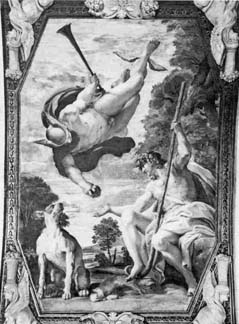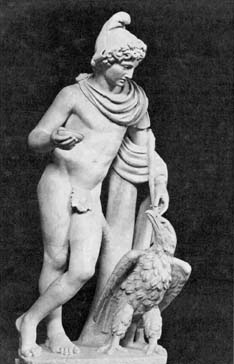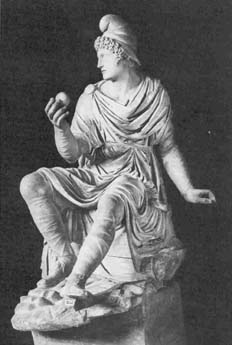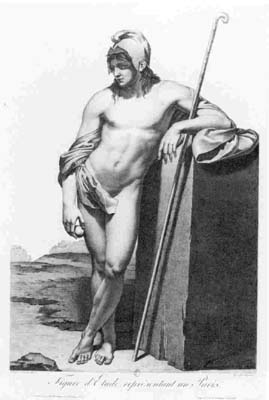
Annual Bulletin 7, 1983-1984
Home
Français
Introduction
History
Annual Index
Author &
Subject
Credits
Contact




The Shepherd Paris of
Jean-Germain Drouais
by John D. Bandiera
Pages 1
| 2
| 3 | 4
| 5
| 6
| 7
The Shepherd Paris may be seen as Drouais' attempt to incorporate his encyclopaedic
study of the art of Rome into a work that would conform to the conventional
standards of academic training. The Rouen picture represents a transitional
phase leading to the full crystallization (in style, political content,
and iconography) of Drouais' art in the Dying Athlete. When The
Shepherd Paris is studied in this new context, it takes its natural
(and logical) place in the development of Drouais' art in 1784 / 1785.
The Shepherd Paris was executed at the beginning of Drouais' period in Rome, when
he was filled with a sense of discovery and was eager to experiment with
a new and diverse set of models. One also sees this in drawing 147 of the Drouais Album,
which is probably a preparatory study for The Shepherd Paris.
It is as close to the finished painting as other
preliminary studies in the Drouais Album are to their respective
académies. In this drawing we see references to a number of sources,
one of which is certainly Annibale Carracci's Mercury Delivering the
Golden Apple to Paris ( fig. 11) in Palazzo Farnese. Drouais was interested
in the work of the Carracci (there are two drawings after Annibale, 89
and 107, in the Drouais Album) and he certainly knew the Palazzo
Farnese frescoes. Annibale's influence is seen in the draped seated figure
with his extended arm, and in the absence of the Phrygian cap. The hairstyles
are also quite similar. In the painting, the connection with Annibale is
evident in details such as the strap that runs across Paris' chest ( this
does not appear in any of the classical sources) and the shepherd's crook
passing under Paris' foot. Equally significant is the composition of the
landscape, with a large group of trees at left, a smaller one at right,
and a view into the distance between. The loose brushy manner in which
the tree and the sky are delineated is also reminiscent of the fresco technique.
To the baroque sources must be added the classical ones. One
that looms quite large is Ganymede (fig. 12), which was prominently
displayed when Drouais was in Rome. (34) Here, as in The Shepherd Paris,
the figure is cross-legged, leans against a tree trunk, holds a shepherd's
staff in the crook of his arm, and wears a Phrygian cap. In both works the
right arm is extended and is holding an object. One can also point to the
similarity in bodily proportions and in the degree of muscular definition
in the torso and legs.
It is highly probable that Drouais consulted statues from classical
antiquity representing the Shepherd Paris. One of these (fig. 13), also
in the Pio Clementino, is a probable source. Paris is represented as a
seated figure who, like the Paris in the National Gallery of Canada, holds
the golden apple before him in his right hand. The facial features, profiles,
and head positions are very similar in the two works.
One should also note that Drouais' figure of Paris is, to a
considerable extent, a generic type that has readily discernible classical
origins. Antique representations of the Shepherd Paris usually show him
standing cross-legged, holding a staff, and leaning against a tree trunk. (35)
He always wears the Phrygian cap - which is associated with the eastern
locale, the slopes of Mount Ida (located in present-day Turkey) - and is
usually looking melancholy. This manner of representation was carried
on in the eighteenth and nineteenth centuries with little deviation from
the time-honoured formula established by the classical prototypes, a continuity
that is apparent in Pierre Gautherot's Figure Study of Paris (fig.14),
a work that closely parallels Drouais' The Shepherd Paris. (36) Gautherot
was a fellow student of Drouais' in David's atelier, and this work is extremely close in spirit to Drouais' académie. The pose is very similar,
especially in the position of the legs, and the major difference between
them is that in Gautherot's work the right arm bangs down at Paris' side
and he leans back on one elbow. Gautherot also deviated from tradition
by having the figure lean on a stone block rather than on a tree stump.
Despite the differences between the two works, it is clear that both artists
were aware of the classical models for figures of this type and neither
proposed a radically new interpretation of his subject.
The Shepherd Paris therefore represents a conservative moment
in Drouais' Roman period. Even so, his originality is readily apparent.
The way that the landscape and the figure are brought together is very
reminiscent of certain aristocratic portraits by van Dyck. This is evident
in the placement of the elongated figure (seen from a relatively low point
of view) in a shallow foreground space in front of a loosely painted naturalistic landscape. Although it is impossible to point to any direct influence
of van Dyck on Drouais, the 'northern' feeling of The Shepherd Paris
is another intriguing aspect of this work.
The diversity of influences, ranging from classical to baroque,
that can be seen in The Shepherd Paris indicate that it is an exploratory
and, to a certain extent, experimental work. It is also a student
work in the fullest sense. It should be remembered, however, that it
was characteristic of Drouais to liberally conflate and transform his sources
and to put his personal stamp on established traditions. (37)
The intent of this paper bas been to formulate a sound circumstantial case for the
attribution of The Shepherd Paris to Jean-Germain Drouais. The
numerous stylistic similarities to the other académies and the evidence
from the Drouais Album all lend considerable support to this view,
and it is Dow possible to state, with reasonable certainty, that The
Shepherd Paris is by Drouais' band and was the first académie he painted in Rome (1784 or early 1785).
Furthermore, if The Shepherd
Paris is by Drouais, it is not as anomalous as some might think. It
squares with Drouais' desire to achieve in his académies a level
of emotional profundity equal to his history paintings. It is also consistent
with Drouais' highly adaptive and wide-ranging approach to models and
stylistic sources, and reflects his enthusiastic study of the art of Rome
in all its richness and variety.
Considering the rarity of Jean-Germain Drouais' finished paintings,
the discovery of another one is a matter of great consequence. The
Shepherd Paris challenges the traditional scholarly perception of Drouais
and shows us his more lyrical and idealizing side. It is also a beautiful
picture, which can be appreciated for its aesthetic and painterly values.
In every respect, it is a special addition to the collection of the National
Gallery of Canada.
Next Page | Notes 1 to 11
1 | 2 | 3 | 4
| 5
| 6
| 7
Annual Index | Author & Subject | Credits | Contact
This digital collection
was produced under contract to Canada's Digital Collections program,
Industry Canada.
"Digital
Collections Program, Copyright
© National Gallery of
Canada 2001"